Ozito ACP-2415 Handleiding
Ozito
Compressor
ACP-2415
Bekijk gratis de handleiding van Ozito ACP-2415 (2 pagina’s), behorend tot de categorie Compressor. Deze gids werd als nuttig beoordeeld door 35 mensen en kreeg gemiddeld 4.3 sterren uit 18 reviews. Heb je een vraag over Ozito ACP-2415 of wil je andere gebruikers van dit product iets vragen? Stel een vraag
Pagina 1/2

Psi
Bar
0
2
4
6 8
10
12
180
150
100
50
0
Psi
Bar
0
2
4
68
10
12
180
150
100
50
0
COMPACT AIR
COMPRESSOR
24 L 1.5HP
INSTRUCTION MANUAL
SPECIFICATIONS
Input: 230–240V ~ 50Hz
Motor: 1100W
No Load Speed: 2,850/min
Tank Volume: 24 litres
Max. Pressure: 8bar (116psi)
Max. Flow Rate: 110 l/min
IP Rating: IP20
Weight: 19.5kg
ACP-2415
WHAT’S IN THE BOX
IN ORDER TO MAKE A CLAIM UNDER THIS
WARRANTY YOU MUST RETURN THE PRODUCT
TO YOUR NEAREST BUNNINGS WAREHOUSE WITH
YOUR BUNNINGS REGISTER RECEIPT. PRIOR TO
RETURNING YOUR PRODUCT FOR WARRANTY
PLEASE TELEPHONE OUR CUSTOMER SERVICE
HELPLINE:
Australia 1800 069 486
New Zealand 0508 069 486
3 YEAR REPLACEMENT WARRANTY
Your product is guaranteed for a period of 36 months from
the original date of purchase. If a product is defective it will
be replaced in accordance with the terms of this warranty.
Warranty excludes consumable parts, for example: air lters and
wheels.
WARNING
The following actions will result in the warranty being void.
• If the tool has been operated on a supply voltage other
than that specied on the tool.
• If the tool shows signs of damage or defects caused
by or resulting from abuse, accidents or alterations.
• Failure to perform maintenance as set out within the
instruction manual.
• If the tool is disassembled or tampered with in any way.
• Professional, industrial or high frequency use.
DESCRIPTION OF SYMBOLS
CARING FOR THE ENVIRONMENT
Power tools that are no longer usable should not be disposed of
with household waste but in an environmentally friendly way. Please
recycle where facilities exist. Check with your local council authority
for recycling advice.
Recycling packaging reduces the need for landll and raw materials.
Reuse of recycled material decreases pollution in the environment.
Please recycle packaging where facilities exist. Check with your
local council authority for recycling advice.
WARRANTY
TO ENSURE A SPEEDY RESPONSE PLEASE
HAVE THE MODEL NUMBER AND DATE OF
PURCHASE AVAILABLE. A CUSTOMER SERVICE
REPRESENTATIVE WILL TAKE YOUR CALL
AND ANSWER ANY QUESTIONS YOU MAY
HAVE RELATING TO THE WARRANTY POLICY
OR PROCEDURE.
OZITO Australia/New Zealand (Head Ofce) 1-23 Letcon Drive, Bangholme, Victoria, Australia 3175.
The benets provided under this warranty are in addition
to other rights and remedies which are available to you at law.
Our goods come with guarantees that cannot be excluded
at law. You are entitled to a replacement or refund for a major
failure and for compensation for any other reasonably foreseeable
loss or damage. You are also entitled to have the goods repaired
or replaced if the goods fail to be of acceptable quality and the
failure does not amount to a major failure.
Generally you will be responsible for all costs associated with
a claim under this warranty, however, where you have suffered
any additional direct loss as a result of a defective product you
may be able to claim such expenses by contacting our customer
service helpline above.
Filter 402050502028
Wheel 402050502062
Rubber Foot 402050502070
Regulator Valve Assy. 402050502003
Spare parts can be ordered from the Special Orders Desk
at your local Bunnings Warehouse.
For further information, or any parts not listed here, visit
www.ozito.com.au or contact Ozito Customer Service:
Australia 1800 069 486
New Zealand 0508 069 486
E-mail: enquires@ozito.com.au
SPARE PARTS
ozito.com.au
This appliance is not intended for use by young or inrm persons unless supervised by a
responsible person to ensure that they can use the appliance safely. Young children should be
supervision to ensure that they do not play with play with the appliance.
WARNING. Before connecting a tool to a power source (mains switch power point
receptacle, outlet, etc.) be sure that the voltage supply is the same as that specied on the
nameplate of the tool. A power source with a voltage greater than that specied for the tool
can result in serious injury to the user, as well as damage to the tool. If in doubt, do not plug in the tool.
Using a power source with a voltage less than the nameplate rating is harmful to the motor.
Always remove the plug from the mains socket before making any adjustments or maintenance.
• To reduce the risk of re or explosion, never spray ammable liquids in a conned area. It is normal
for the compressor motor and pressure switch to produce sparks during use. If sparks come into
contact with petrol vapours or solvents, they may ignite the vapours and cause a re or explosion.
• Always operate the compressor in a well ventilated area. Do not smoke while spraying. Do not
spray where sparks or ames are present. Keep the compressor as far away from the spray area as
possible.
• The solvents trichloroethane and methylene chloride can chemically react with the aluminium
used in some paint spray guns and form an explosion. If these solvents are used, ensure that only
stainless steel spray equipment is connected. The compressor is not affected by the use of these
solvents.
• Never directly inhale the compressed air produced by a compressor and do not use it for charging
breathing tanks.
• Do not use welding equipment in close proximity to the compressor. Do not weld anything to the air
tank of the compressor: this could dangerously weaken the tank and will void the warranty.
• Do not use the compressor outdoors when it is raining or on a wet surface; either situation could
cause an electric shock.
• Always shut off the compressor after use and before servicing. Push the on/off knob down, wait for
the pressurised air to bleed from the tank from the release valve and then remove the electrical plug
from the power supply.
• Check the maximum pressure rating of any tools or accessories that you intend using with the
compressor. The output pressure of the air from the compressor must be regulated so that it never
exceeds the rated pressure of the tool or accessory.
• To avoid the risk of burns and injury from moving parts, do not operate the compressor with the
safety shield removed. Allow hot parts to cool before handling or servicing.
Be certain to read all the labels on the containers of paint or other materials to be sprayed. Closely
follow all safety instructions. Use a respirator mask if there is a chance that you might otherwise
inhale the spray material. Carefully check the effectiveness of any respirator mask you intend using.
• Always wear safety goggles or glasses when using the air compressor. Never point the nozzle of an
accessory towards any part of your body or towards another person.
• Do not attempt to adjust the pressure switch or the release valve located under the pressure switch
cover.
• Drain the moisture from the tank daily. It will help prevent corrosion.
• Pull the ring on the safety valve daily to ensure that it operating properly and to clear any possible
instructions.
• Keep the compressor at least 300mm from the nearest wall to ensure adequate ventilation for
cooling purposes.
• Before transporting the compressor make sure that the pressurised air is bled from the tank and
that the compressor is rmly secured.
• Protect the air hose and cordset from damage. Inspect for weak or worn spots regularly and replace
if necessary.
• Avoid using an extension cord with this product. Use additional air hose instead of an extension
cord to prevent power loss and possible damage to the motor. Use of an extension cord voids the
warranty.
• After long working periods external metal parts could be hot.
• Always press the on/off button down to switch off the compressor before switching off the power or
removing the power plug.
• After using the compressor, switch off the on/off button, disconnect the power supply and open the
outlet valve to release the pressure.
• Do not attempt to remove any part of the machine whilst it is under pressure.
• Use safety equipment including safety goggles or shield, ear protection, breathing or respirator
mask and protective clothing.
• Never attempt to remove any part of the compressor whilst the tank is under pressure.
Wear goggles, wear earmuffs, wear a breathing mask
Never apply the outlet air of this compressor directly on to any part of a person’s body. Do not attempt to
block the air outlet with your nger or any part of your body.
The tool must be used only for its prescribed purpose. Any use other than those mentioned in this
Manual will be considered a case of misuse. The user and not the manufacturer shall be liable for any
damage or injury resulting from such cases of misuse.
The manufacturer shall not be liable for any changes made to the tool nor for any damage resulting from
such changes.
Even when the tool is used as prescribed it is not possible to eliminate all residual risk factors. The
following hazards may arise in connection with the tool’s construction and design:
• Damage to the lungs if an effective breathing mask is not worn.
• Damage to hearing if effective earmuffs are not worn.
• Damage to the eyes if effective safety goggles or shield are not worn.
WARNING. In the event that an air line is cut or broken, the air supply must be turned off at the
compressor. A broken air line which is not supported is extremely dangerous and can whip around
very quickly, both with the capability of striking people, and blowing foreign particles into the air.
Do not attempt to catch the air line but immediately keep bystanders well clear and turn off the air
supply to the hose, turn off the compressor at the On / Off button, and then remove the hose from the
compressor.
AIR COMPRESSOR SAFETY WARNINGS
WARNING! When using mains-powered tools, basic safety precautions, including
the following, should always be followed to reduce risk of re, electric shock,
personal injury and material damage.
Read the whole manual carefully and make sure you know how to switch the tool off in an
emergency, before operating the tool.
Save these instructions and other documents supplied with this tool for future reference.
The electric motor has been designed for 230V and 240V only. Always check that the power supply
corresponds to the voltage on the rating plate.
The tool is earthed in accordance with AS/NZS 60335:2002
Note: The supply of 230V and 240V on Ozito tools are interchangeable for Australia and New
Zealand.
If operating a power tool in a damp location is unavoidable use a residual current device (RCD)
protected supply. Use of an RCD reduces the risk of electric shock.
If the supply cord is damaged, it must be replaced by an electrician or a power tool repairer in order
to avoid a hazard.
Using an Extension Lead
Always use an approved extension lead suitable for the power input of this tool. Before use, inspect
the extension lead for signs of damage, wear and ageing. Replace the extension lead if damaged
or defective.
When using an extension lead on a reel, always unwind the lead completely. Use of an extension
lead not suitable for the power input of the tool or which is damaged or defective may result in a risk
of re and electric shock.
WARNING! Read all safety warnings and all instructions. Failure to follow the
warnings and instructions may result in electric shock, re and/or serious injury.
Save all warnings and instructions for future reference. The term “power tool” in the
warnings refers to your mains-operated (corded) power tool or battery-operated (cordless)
power tool.
1. Work area safety
a. Keep work area clean and well lit. Cluttered or dark areas invite accidents.
b.
Do not operate power tools in explosive atmospheres, such as in the presence of ammable
liquids, gases or dust. Power tools create sparks which may ignite the dust or fumes.
c. Keep children and bystanders away while operating a power tool. Distractions can cause
you to lose control.
2. Electrical safety
a. Power tool plugs must match the outlet. Never modify the plug in any way.
Do not use any adapter plugs with earthed (grounded) power tools. Unmodied plugs and
matching outlets will reduce risk of electric shock.
b. Avoid body contact with earthed or grounded surfaces, such as pipes, radiators, ranges
and refrigerators. There is an increased risk of electric shock if your body is earthed or
grounded.
c. Do not expose power tools to rain or wet conditions. Water entering a power tool will
increase the risk of electric shock.
d. Do not abuse the cord. Never use the cord for carrying, pulling or unplugging the power
tool. Keep cord away from heat, oil, sharp edges or moving parts. Damaged or entangled
cords increase the risk of electric shock.
e. When operating a power tool outdoors, use an extension cord suitable for outdoor use.
Use of a cord suitable for outdoor use reduces the risk of electric shock.
f. If operating a power tool in a damp location is unavoidable, use a residual current device
(RCD) protected supply. Use of an RCD reduces the risk of electric shock.
3. Personal safety
a. Stay alert, watch what you are doing and use common sense when operating a power
tool. Do not use a power tool while you are tired or under the inuence of drugs, alcohol
or medication.
A moment of inattention while operating power tools may result in serious personal injury.
b. Use personal protective equipment. Always wear eye protection. Protective equipment
such as dust mask, non-skid safety shoes, hard hat, or hearing protection used for appropriate
conditions will reduce personal injuries.
c. Prevent unintentional starting. Ensure the switch is in the off-position before connecting
to power source and/or battery pack, picking up or carrying the tool. Carrying power
tools with your nger on the switch or energising power tools that have the switch on invites
accidents.
d. Remove any adjusting key or wrench before turning the power tool on.
A wrench or a key left attached to a rotating part of the power tool may result in personal injury.
e. Do not overreach. Keep proper footing and balance at all times. This enables better control
of the power tool in unexpected situations.
f. Dress properly. Do not wear loose clothing or jewellery. Keep your hair, clothing and gloves
away from moving parts. Loose clothes, jewellery or long hair can be caught in moving parts.
g. If devices are provided for the connection of dust extraction and collection facilities,
ensure these are connected and properly used. Use of dust collection can reduce dust-
related hazards.
4. Power tool use and care
a. Do not force the power tool. Use the correct power tool for your application. The correct
power tool will do the job better and safer at the rate for which it was designed.
b. Do not use the power tool if the switch does not turn it on and off. Any power tool that
cannot be controlled with the switch is dangerous and must be repaired.
c. Disconnect the plug from the power source and/or the battery pack from the power tool
before making any adjustments, changing accessories, or storing power tools. Such
preventive safety measures reduce the risk of starting the power tool accidentally.
d. Store idle power tools out of the reach of children and do not allow persons unfamiliar
with the power tool or these instructions to operate the power tool. Power tools are
dangerous in the hands of untrained users.
e. Maintain power tools. Check for misalignment or binding of moving parts, breakage of
parts and any other condition that may affect the power tool’s operation. If damaged,
have the power tool repaired before use. Many accidents are caused by poorly maintained
power tools.
f. Keep cutting tools sharp and clean. Properly maintained cutting tools with sharp cutting
edges are less likely to bind and are easier to control.
g. Use the power tool, accessories and tool bits etc. in accordance with these instructions,
taking into account the working conditions and the work to be performed. Use of the
power tool for operations different from those intended could result in a hazardous situation.
5. Service
a. Have your power tool serviced by a qualied repair person using only identical
replacement parts. This will ensure that the safety of the power tool is maintained.
b. If the supply cord is damaged, it must be replaced by the manufacturer,
its service agent or similarly qualied persons in order to avoid a hazard.
GENERAL POWER TOOL SAFETY WARNINGS - PERSONAL SAFETY
ELECTRICAL SAFETY
1113
VVolts Hz Hertz
~Alternating current WWatts
min¯
Revolutions or
reciprocation per minute
no No load speed
Warning
Wear hearing protection
Read instruction manual
Beware of electrical voltage
Regulator compliance mark
Beware of hot parts.
94
Sound power level
Pressure ratingbar
lLitres
4. CLEANING & MAINTENANCE
MAINTENANCE
5. STORAGE
Cleaning the air lter
The air lter prevents dust and dirt being drawn in. It is essential to
clean this lter after at least every 300 hours of service. A clogged air
lter will decrease the compressor’s performance dramatically.
1. Remove the lter from the
compressor by unscrewing the
screw on the plastic cover.
2. Lift off the plastic cover and
remove the intake air lter
beneath.
3. Carefully clean the lter by
tapping or blowing it with low
pressure compressed air
(approx. 3 bar). To assemble,
proceed in reverse order.
IMPORTANT! BEFORE CLEANING YOUR OIL FREE AIR
COMPRESSOR OR CARRYING OUT ANY MAINTENANCE
PROCEDURE, MAKE SURE THAT THE MOTOR IS OFF AND
THE TOOL DISCONNECTED FROM THE POWER SUPPLY
TO PREVENT ACCIDENTAL STARTING.
IMPORTANT! WAIT UNTIL THE COMPRESSOR HAS
COMPLETELY COOLED DOWN. RISK OF BURNS!
IMPORTANT! ALWAYS DEPRESSURIZE THE TANK BEFORE
CARRYING OUT ANY CLEANING AND MAINTENANCE WORK.
• Check the tank for signs of rust and damage each time before
using. Do not use the compressor with a damaged or rusty tank.
Cleaning
• Keep the safety devices free of dirt and dust as far as possible.
Wipe the equipment with a clean cloth or blow it with compressed air
at low pressure.
• We recommend that you clean the appliance immediately after you
use it.
• Clean the appliance regularly with a damp cloth and some soft soap.
Do not use cleaning agents or solvents; these may be aggressive to
the plastic parts in the appliance. Ensure that no water can get into
the interior of the appliance.
• You must disconnect the hose and any spraying tools from the
compressor before cleaning. Do not clean the compressor with
water, solvents or the like.
Removing
condensation water
The condensation water must be
drained off each use by opening the
drain plug, at the bottom of the tank.
The drain plug can be opened by
turning the screw in an anti-clockwise
direction.
IMPORTANT! PULL THE MAINS PLUG OUT OF THE
SOCKET AND VENTILATE THE APPLIANCE AND ALL
CONNECTED PNEUMATIC TOOLS. SWITCH OFF THE
COMPRESSOR AND MAKE SURE THAT IT IS SECURED
IN SUCH A WAY THAT IT CANNOT BE STARTED UP AGAIN
BY ANY UNAUTHORISED PERSON.
IMPORTANT! STORE THE COMPRESSOR ONLY IN
A DRY LOCATION WHICH IS NOT ACCESSIBLE TO
UNAUTHORISED PERSONS. ALWAYS STORE UPRIGHT,
NEVER TILTED!
Psi
Bar
0
2
4
68
10
12
180
150
100
50
0
Psi
Bar
0
2
4
68
10
12
180
150
100
50
0
Compact Air Compressor
Wheels x 2, caps x 2,
at washers x 4, spring
washers x 2, bolts x 2,
nuts x 2, nyloc nuts x 2
Rubber foot, nut,
bolt, washers x 3

ONLINE MANUAL
Scan this QR Code with your
mobile device to take you to
the online manual.
Psi
Bar
0
2
4
6
10
12
180
150
100
50
0
Psi
Bar
0
2
4
68
10
12
180
150
100
50
0
Preset pressure
The minimum and maximum preset
tank pressure can be read from
the tank pressure gauge. This tank
pressure is set at the factory and the
operator should not alter it.
Switch-on pressure 6 bar
Switch-off pressure 8 bar
Note. When the maximum preset
tank pressure is reached, the motor will automatically switch Off. As
the compressed air is used, the pressure will drop until it reaches the
preset minimum pressure, when the minimum pressure is reached
the compressor will turn on again automatically to build up/maintain
pressure.
Fitting the supporting foot
1. Align the hole in the supporting
foot with the hole in the supporting
foot bracket.
2. Insert the bolt through a washer
and then up through the supporting
foot and the hole in the frame.
3. From the inside of the supporting foot
bracket, place the washer, then the
spring washer onto the bolt. Fasten the
assembly in place with the nut (nuts,
bolts and washers supplied).
Switching On/Off
1. Attach the desired tool to the
quick release regulated air
outlet.
2. To switch the compressor On,
pull up the knob.
3. To switch the compressor Off,
press the knob down.
Adjusting the pressure
1. Once set up and On you can adjust
the air pressure by turning the
pressure regulating knob.
2. To increase the air pressure, rotate
the regulating knob clockwise. To
decrease the pressure, rotate the
regulating knob anti-clockwise.
Note. Air must be owing through the
quick release regulated air outlet, and
the attached air tool in order to obtain the
correct output reading on the pressure
gauge.
1. Quick-release regulated air
outlet
2. Transportation handle
3. Pressure regulating knob
4. ON/OFF switch
5. Tank pressure gauge
6. Housing cover
7. Safety valve
8. Outlet pressure gauge
9. Supporting foot bracket
10. Supporting foot
11. Drain plug
12. Tank
13. Intake air lter
14. Wheel bracket
15. Wheel
COMPACT AIR COMPRESSOR
KNOW YOUR PRODUCT
ACP-2415
1. ASSEMBLY 3. TROuBLE ShOOTING2. OPERATION
Pre setup checks
• Examine the machine for signs of transit damage. If damaged, do not
use, contact Ozito .
• The compressor should be set up near the area of use.
• Avoid long air lines and long supply lines (extensions).
• Make sure the intake air is dry and dust-free.
• Do not set up the compressor in damp or wet rooms.
• The compressor may only be used in suitable rooms (with good
ventilation and an ambient temperature from 5°C to 40°C). There must
be no dust, acids, vapours, explosive gases or inammable gases in
the room.
• The compressor is designed to be used in dry rooms. It is prohibited
to use the compressor in areas where work is conducted with sprayed
water. Before you use the machine, make sure that the mains voltage
complies with the specications on the rating plate.
Fitting the wheels
Note. You must fully assemble the
compressor before using it for the rst time.
1. Place a washer onto the bolt and t the
bolt into the wheel. Now t washer and
nyloc nut on the thread of the bolt and
tighten.
2. Insert the wheel bolt through the hole
in the wheel bracket, below the tank.
3 From the inside of the wheel bracket,
place a spring washer on the wheel bolt.
Fasten the wheel bolt in position with a nut
(nuts and washers supplied).
4. Clip the hub cap to the outer
face of the wheel.
5. Repeat steps 1 to 4 with the
second wheel.
SETUP & PREPARATION OPERATION
1 2 3 4 5 6
8 12 13 14 159 10 117
Psi
Bar
0
2
4
6
8
10
12
180
150
100
50
0
Psi
Bar
0
2
4
6
8
10
12
180
150
100
50
0
Psi
Bar
0
2
4
6
8
10
12
180
150
100
50
0
Psi
Bar
0
2
4
6
8
10
12
180
150
100
50
0
Psi
Bar
0
2
4
68
10
12
180
150
100
50
0
Psi
Bar
6
8
10
12
180
150
100
0
Psi
Bar
0
2
4
6
8
10
12
180
150
100
50
0
Psi
Bar
0
2
4
6
8
10
12
180
150
100
50
0
Turning Off
1. After the task has been completed,
switch the compressor Off by
pressing down the On/Off knob.
2 Switch off the mains power supply
and remove the electrical plug.
3. Release the remaining compressed air in the tank by use of an air
tool (blow gun etc).
Note: By pulling the ring on the safety
valve outwards, is also suitable
for releasing the remaining
compressed air in the tank.
Release the ring so that the safety
valve closes.
Problem Cause Solution
The compressor
does not start
1. No power supply 1. Check the power
supply, the power
plug and the
socket-outlet.
2. Insufcient supply
power
2. Make sure that
the extension
cable is not too
long.
3. Outside temperature
is too low
3. Never operate
with an outside
temperature of
below 5°c.
4. Motor is overheated 4. Allow the motor
to cool down.
If necessary,
remedy the
cause of the
overheating.
The compressor
starts but there
is no pressure
1. Leak in the non-
return valve
1. Replace the non-
return valve
2. The seals are
damaged.
2. Check the seals
and have any
damaged seals
replaced by a
service centre
3. The drain plug leaks. 3. Tighten the
screw by hand.
check the seal
on the screw
and replace if
necessary.
The compressor
starts, pressure
is shown on the
pressure gauge,
but no pressure to
the air tool.
1. Loose hose
connections
1. Check the
compressed air
hose and tools
and replace if
necessary.
2. Leak in a quick-lock
coupling
2. Check the quick-
lock coupling
and replace if
necessary.
3. Insufcient pressure
set on the pressure
regulator.
3. Open the
pressure
regulator further.
Checking the safety valve
1. Check that the safety valve is in
working order every use. Turn
compressor on until the switch off
pressure (8 bar) is reached.
2. Hold the ring on the safety valve and
pull it outwards. Air should discharge
from the valve.
3. When the ring on the safety
valve is released the air discharge
should stop.
68
Psi
Bar
0
2
4
8
10
12
180
150
100
50
0
Psi
Bar
0
4
68
10
12
150
100
50
0
Psi
Bar
0
2
4
68
10
12
180
150
100
50
0
Psi
Bar
0
2
4
68
10
12
180
150
100
50
0
WARNING!: WARNING! DO NO USE THE
COMPRESSOR IF THE SAFETY VALVE DOES NOT
WORK AS DESCRIBED.
WARNING!: WEAR SAFETY GLASSES AND EAR
PROTECTION. KEEP YOUR FACE AWAY FROM THE
SAFETY VALVE WHEN CARRYING OUT THIS CHECK.
AIR WILL BE DISCHARGED AT A HIGH PRESSURE.
WARNING! TAKE CARE WHEN DISCHARGING AIR
THROUGH THE SAFETY VALVE, DRAIN PLUG OR THE
AIR OUTLET. THE DISCHARGE AIR CAN CAUSE DUST,
STONES OR ANY OTHER FOREIGN PARTICLES TO BE
BLOWN THROUGH THE AIR AT HIGH PRESSURE.
Product specificaties
| Merk: | Ozito |
| Categorie: | Compressor |
| Model: | ACP-2415 |
Heb je hulp nodig?
Als je hulp nodig hebt met Ozito ACP-2415 stel dan hieronder een vraag en andere gebruikers zullen je antwoorden
Handleiding Compressor Ozito

8 April 2024

16 Maart 2024

16 Maart 2024

29 Augustus 2023

28 Mei 2023

22 Mei 2023

20 Mei 2023

18 Mei 2023

16 Mei 2023

29 Maart 2023
Handleiding Compressor
- Topcraft
- Laica
- Prowork
- Freeman
- Auto Joe
- Silvercrest
- California Air Tools
- CMI
- Samson
- Pretul
- Scheppach
- Truper
- Bavaria
- Emax
- Golden Age Project
Nieuwste handleidingen voor Compressor
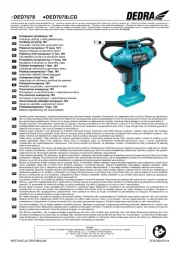
15 Juli 2025
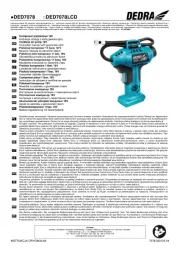
15 Juli 2025
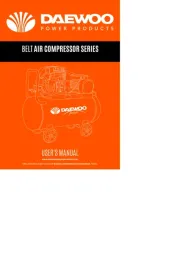
15 Juli 2025
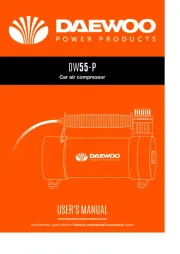
15 Juli 2025
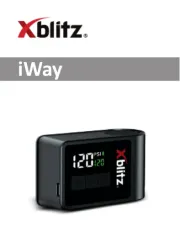
15 Juli 2025
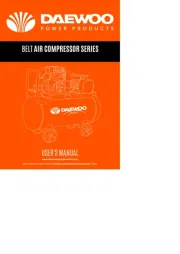
15 Juli 2025
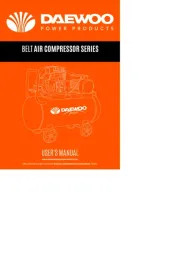
14 Juli 2025
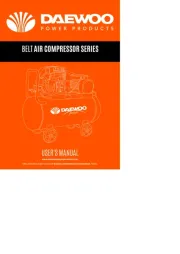
14 Juli 2025
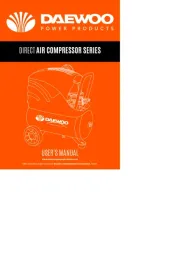
14 Juli 2025
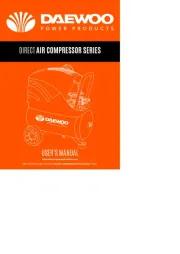
14 Juli 2025